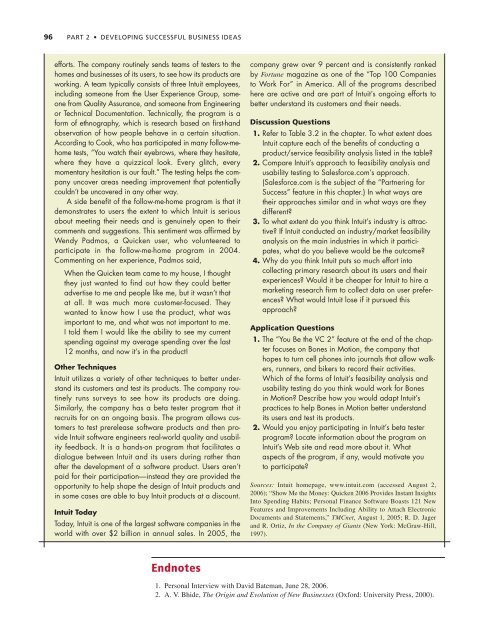feasibility analysis feasibility analysis
feasibility analysis feasibility analysis
feasibility analysis feasibility analysis
You also want an ePaper? Increase the reach of your titles
YUMPU automatically turns print PDFs into web optimized ePapers that Google loves.
96 PART 2 • DEVELOPING SUCCESSFUL BUSINESS IDEAS<br />
efforts. The company routinely sends teams of testers to the<br />
homes and businesses of its users, to see how its products are<br />
working. A team typically consists of three Intuit employees,<br />
including someone from the User Experience Group, someone<br />
from Quality Assurance, and someone from Engineering<br />
or Technical Documentation. Technically, the program is a<br />
form of ethnography, which is research based on first-hand<br />
observation of how people behave in a certain situation.<br />
According to Cook, who has participated in many follow-mehome<br />
tests, “You watch their eyebrows, where they hesitate,<br />
where they have a quizzical look. Every glitch, every<br />
momentary hesitation is our fault.” The testing helps the company<br />
uncover areas needing improvement that potentially<br />
couldn’t be uncovered in any other way.<br />
A side benefit of the follow-me-home program is that it<br />
demonstrates to users the extent to which Intuit is serious<br />
about meeting their needs and is genuinely open to their<br />
comments and suggestions. This sentiment was affirmed by<br />
Wendy Padmos, a Quicken user, who volunteered to<br />
participate in the follow-me-home program in 2004.<br />
Commenting on her experience, Padmos said,<br />
When the Quicken team came to my house, I thought<br />
they just wanted to find out how they could better<br />
advertise to me and people like me, but it wasn’t that<br />
at all. It was much more customer-focused. They<br />
wanted to know how I use the product, what was<br />
important to me, and what was not important to me.<br />
I told them I would like the ability to see my current<br />
spending against my average spending over the last<br />
12 months, and now it’s in the product!<br />
Other Techniques<br />
Intuit utilizes a variety of other techniques to better understand<br />
its customers and test its products. The company routinely<br />
runs surveys to see how its products are doing.<br />
Similarly, the company has a beta tester program that it<br />
recruits for on an ongoing basis. The program allows customers<br />
to test prerelease software products and then provide<br />
Intuit software engineers real-world quality and usability<br />
feedback. It is a hands-on program that facilitates a<br />
dialogue between Intuit and its users during rather than<br />
after the development of a software product. Users aren’t<br />
paid for their participation—instead they are provided the<br />
opportunity to help shape the design of Intuit products and<br />
in some cases are able to buy Intuit products at a discount.<br />
Intuit Today<br />
Today, Intuit is one of the largest software companies in the<br />
world with over $2 billion in annual sales. In 2005, the<br />
company grew over 9 percent and is consistently ranked<br />
by Fortune magazine as one of the “Top 100 Companies<br />
to Work For” in America. All of the programs described<br />
here are active and are part of Intuit’s ongoing efforts to<br />
better understand its customers and their needs.<br />
Discussion Questions<br />
1. Refer to Table 3.2 in the chapter. To what extent does<br />
Intuit capture each of the benefits of conducting a<br />
product/service <strong>feasibility</strong> <strong>analysis</strong> listed in the table?<br />
2. Compare Intuit’s approach to <strong>feasibility</strong> <strong>analysis</strong> and<br />
usability testing to Salesforce.com’s approach.<br />
(Salesforce.com is the subject of the “Partnering for<br />
Success” feature in this chapter.) In what ways are<br />
their approaches similar and in what ways are they<br />
different?<br />
3. To what extent do you think Intuit’s industry is attractive?<br />
If Intuit conducted an industry/market <strong>feasibility</strong><br />
<strong>analysis</strong> on the main industries in which it participates,<br />
what do you believe would be the outcome?<br />
4. Why do you think Intuit puts so much effort into<br />
collecting primary research about its users and their<br />
experiences? Would it be cheaper for Intuit to hire a<br />
marketing research firm to collect data on user preferences?<br />
What would Intuit lose if it pursued this<br />
approach?<br />
Application Questions<br />
1. The “You Be the VC 2” feature at the end of the chapter<br />
focuses on Bones in Motion, the company that<br />
hopes to turn cell phones into journals that allow walkers,<br />
runners, and bikers to record their activities.<br />
Which of the forms of Intuit’s <strong>feasibility</strong> <strong>analysis</strong> and<br />
usability testing do you think would work for Bones<br />
in Motion? Describe how you would adapt Intuit’s<br />
practices to help Bones in Motion better understand<br />
its users and test its products.<br />
2. Would you enjoy participating in Intuit’s beta tester<br />
program? Locate information about the program on<br />
Intuit’s Web site and read more about it. What<br />
aspects of the program, if any, would motivate you<br />
to participate?<br />
Sources: Intuit homepage, www.intuit.com (accessed August 2,<br />
2006); “Show Me the Money: Quicken 2006 Provides Instant Insights<br />
Into Spending Habits; Personal Finance Software Boasts 121 New<br />
Features and Improvements Including Ability to Attach Electronic<br />
Documents and Statements,” TMCnet, August 1, 2005; R. D. Jager<br />
and R. Ortiz, In the Company of Giants (New York: McGraw-Hill,<br />
1997).<br />
Endnotes<br />
1. Personal Interview with David Bateman, June 28, 2006.<br />
2. A. V. Bhide, The Origin and Evolution of New Businesses (Oxford: University Press, 2000).

















